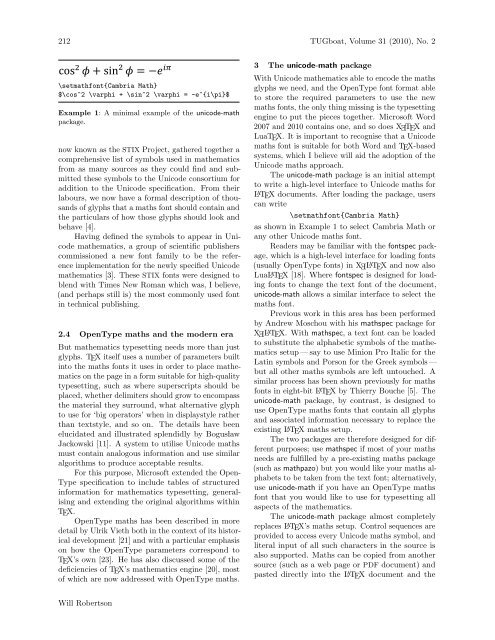Unicode mathematics in LATEX: Advantages and challenges - TUG
Unicode mathematics in LATEX: Advantages and challenges - TUG
Unicode mathematics in LATEX: Advantages and challenges - TUG
You also want an ePaper? Increase the reach of your titles
YUMPU automatically turns print PDFs into web optimized ePapers that Google loves.
212 <strong>TUG</strong>boat, Volume 31 (2010), No. 2<br />
cos φ + s<strong>in</strong> φ = −e <br />
\setmathfont{Cambria Math}<br />
$\cos^2 \varphi + \s<strong>in</strong>^2 \varphi = -e^{i\pi}$<br />
Example 1: A m<strong>in</strong>imal example of the unicode-math<br />
package.<br />
now known as the STIX Project, gathered together a<br />
comprehensive list of symbols used <strong>in</strong> <strong>mathematics</strong><br />
from as many sources as they could f<strong>in</strong>d <strong>and</strong> submitted<br />
these symbols to the <strong>Unicode</strong> consortium for<br />
addition to the <strong>Unicode</strong> specification. From their<br />
labours, we now have a formal description of thous<strong>and</strong>s<br />
of glyphs that a maths font should conta<strong>in</strong> <strong>and</strong><br />
the particulars of how those glyphs should look <strong>and</strong><br />
behave [4].<br />
Hav<strong>in</strong>g def<strong>in</strong>ed the symbols to appear <strong>in</strong> <strong>Unicode</strong><br />
<strong>mathematics</strong>, a group of scientific publishers<br />
commissioned a new font family to be the reference<br />
implementation for the newly specified <strong>Unicode</strong><br />
<strong>mathematics</strong> [3]. These STIX fonts were designed to<br />
blend with Times New Roman which was, I believe,<br />
(<strong>and</strong> perhaps still is) the most commonly used font<br />
<strong>in</strong> technical publish<strong>in</strong>g.<br />
2.4 OpenType maths <strong>and</strong> the modern era<br />
But <strong>mathematics</strong> typesett<strong>in</strong>g needs more than just<br />
glyphs. TEX itself uses a number of parameters built<br />
<strong>in</strong>to the maths fonts it uses <strong>in</strong> order to place <strong>mathematics</strong><br />
on the page <strong>in</strong> a form suitable for high-quality<br />
typesett<strong>in</strong>g, such as where superscripts should be<br />
placed, whether delimiters should grow to encompass<br />
the material they surround, what alternative glyph<br />
to use for ‘big operators’ when <strong>in</strong> displaystyle rather<br />
than textstyle, <strong>and</strong> so on. The details have been<br />
elucidated <strong>and</strong> illustrated splendidly by Bogus̷law<br />
Jackowski [11]. A system to utilise <strong>Unicode</strong> maths<br />
must conta<strong>in</strong> analogous <strong>in</strong>formation <strong>and</strong> use similar<br />
algorithms to produce acceptable results.<br />
For this purpose, Microsoft extended the Open-<br />
Type specification to <strong>in</strong>clude tables of structured<br />
<strong>in</strong>formation for <strong>mathematics</strong> typesett<strong>in</strong>g, generalis<strong>in</strong>g<br />
<strong>and</strong> extend<strong>in</strong>g the orig<strong>in</strong>al algorithms with<strong>in</strong><br />
TEX.<br />
OpenType maths has been described <strong>in</strong> more<br />
detail by Ulrik Vieth both <strong>in</strong> the context of its historical<br />
development [21] <strong>and</strong> with a particular emphasis<br />
on how the OpenType parameters correspond to<br />
TEX’s own [23]. He has also discussed some of the<br />
deficiencies of TEX’s <strong>mathematics</strong> eng<strong>in</strong>e [20], most<br />
of which are now addressed with OpenType maths.<br />
3 The unicode-math package<br />
With <strong>Unicode</strong> <strong>mathematics</strong> able to encode the maths<br />
glyphs we need, <strong>and</strong> the OpenType font format able<br />
to store the required parameters to use the new<br />
maths fonts, the only th<strong>in</strong>g miss<strong>in</strong>g is the typesett<strong>in</strong>g<br />
eng<strong>in</strong>e to put the pieces together. Microsoft Word<br />
2007 <strong>and</strong> 2010 conta<strong>in</strong>s one, <strong>and</strong> so does X TEX <strong>and</strong><br />
LuaTEX. It is important to recognise that a <strong>Unicode</strong><br />
maths font is suitable for both Word <strong>and</strong> TEX-based<br />
systems, which I believe will aid the adoption of the<br />
<strong>Unicode</strong> maths approach.<br />
The unicode-math package is an <strong>in</strong>itial attempt<br />
to write a high-level <strong>in</strong>terface to <strong>Unicode</strong> maths for<br />
L A TEX documents. After load<strong>in</strong>g the package, users<br />
can write<br />
\setmathfont{Cambria Math}<br />
as shown <strong>in</strong> Example 1 to select Cambria Math or<br />
any other <strong>Unicode</strong> maths font.<br />
Readers may be familiar with the fontspec package,<br />
which is a high-level <strong>in</strong>terface for load<strong>in</strong>g fonts<br />
(usually OpenType fonts) <strong>in</strong> X L A TEX <strong>and</strong> now also<br />
LuaL A TEX [18]. Where fontspec is designed for load<strong>in</strong>g<br />
fonts to change the text font of the document,<br />
unicode-math allows a similar <strong>in</strong>terface to select the<br />
maths font.<br />
Previous work <strong>in</strong> this area has been performed<br />
by Andrew Moschou with his mathspec package for<br />
X L A TEX. With mathspec, a text font can be loaded<br />
to substitute the alphabetic symbols of the <strong>mathematics</strong><br />
setup — say to use M<strong>in</strong>ion Pro Italic for the<br />
Lat<strong>in</strong> symbols <strong>and</strong> Porson for the Greek symbols —<br />
but all other maths symbols are left untouched. A<br />
similar process has been shown previously for maths<br />
fonts <strong>in</strong> eight-bit L A TEX by Thierry Bouche [5]. The<br />
unicode-math package, by contrast, is designed to<br />
use OpenType maths fonts that conta<strong>in</strong> all glyphs<br />
<strong>and</strong> associated <strong>in</strong>formation necessary to replace the<br />
exist<strong>in</strong>g L A TEX maths setup.<br />
The two packages are therefore designed for different<br />
purposes; use mathspec if most of your maths<br />
needs are fulfilled by a pre-exist<strong>in</strong>g maths package<br />
(such as mathpazo) but you would like your maths alphabets<br />
to be taken from the text font; alternatively,<br />
use unicode-math if you have an OpenType maths<br />
font that you would like to use for typesett<strong>in</strong>g all<br />
aspects of the <strong>mathematics</strong>.<br />
The unicode-math package almost completely<br />
replaces L A TEX’s maths setup. Control sequences are<br />
provided to access every <strong>Unicode</strong> maths symbol, <strong>and</strong><br />
literal <strong>in</strong>put of all such characters <strong>in</strong> the source is<br />
also supported. Maths can be copied from another<br />
source (such as a web page or PDF document) <strong>and</strong><br />
pasted directly <strong>in</strong>to the L A TEX document <strong>and</strong> the<br />
E<br />
E<br />
E<br />
Will Robertson

















